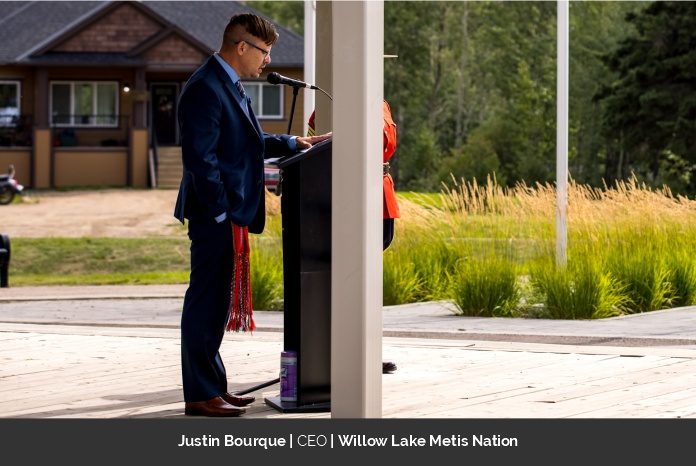
The focus of the agreement is to develop a transdisciplinary approach to revitalizing, developing, and monitoring the Nation’s recently acquired land in Fort McMurray.
Anzac, Alberta–(Newsfile Corp. – June 7, 2022) – Willow Lake Métis Nation (WLMN), an Anzac, Alberta-based Métis community, and the Resilience Institute (TRI), a national education and research institute, have signed a memorandum of understanding (MOU). The formal partnership is directly related to WLMN’s land acquisition and Sohkastwâwin initiative.
WLMN and TRI plan to take a transdisciplinary approach to revitalizing, developing, and monitoring the approximately 205 acres of land WLMN recently acquired, which has been highly impacted by industry activity. TRI is a charitable organization that partners with local and Indigenous Peoples, academia, and industry on multi-pronged initiatives to build resilience to current and future impacts of climate change.
“Sohkastwâwin is a Cree term for ‘the act of being resilient’ and it is the future for our people,” says Justin Bourque, CEO of WLMN. “Sohkastwâwin is an ecosystem of food, culture, and economy that will provide our citizens the ability to maintain resilience in an ever-changing future on climate change and bolster our ability to adapt. We are grateful for the opportunity to work with the Resilience Institute on this important initiative.”
“This initiative exemplifies the meaning of doing business differently in contrast to ‘business as usual’ in the context of climate change and the impacts it is unleashing on communities,” says TRI’s Founder and President, Laura S. Lynes. “By taking a transdisciplinary approach to Sohkastwâwin we bring together the wisdom of local and traditional knowledge holders with the best available science to meet the community’s objectives. We’re really excited about this journey.”
The partnership was bolstered by a $30,000 community investment by Keyera Corp. (“Keyera”) (TSX: KEY). The generous donation will be used to fund the crucial cultural and scientific research to support TRI’s work and WLMN’s vision, including creating holistic land development and monitoring plans for the Nation. Next steps include assessing the current landscape and gaining an understanding of the proposed impacts of their plans for the land from a climate lens. The University of Saskatchewan has been engaged to undertake the groundwork.
“Keyera is pleased to support the future development and vision for this land through our $30,000 donation and wish Willow Lake Metis Nation great success as they step forward in this journey,” says Dean Setoguchi, Keyera President & Chief Executive Officer. “At Keyera, we strongly believe in the power of collaboration and seek partnerships with those who have likeminded goals, such as sustainability and community resiliency. That’s why we’re honoured to support the Sohkastwâwin initiative and look forward to continued growth of our relationship with Willow Lake Metis Nation.”
Sohkastwâwin will accomplish many goals, including economic benefit – not only for the Nation, but the whole community. The cultural space will provide traditional food, medicine, material, and reclamation sources for WLMN citizens and the entire region while allowing them to share their traditional ways with others to promote their Métis culture. Above all else, Sohkastwâwin will reconnect WLMN with the bison: a culturally important keystone animal.
The creation of this sustainable resource will prepare the Nation, and future generations of WLMN citizens, to handle an environment and economy impacted by climate change. WLMN plans to start with 20 heads and will work with its industry partners to increase the herd over time. A new partnership will then form: one between the WLMN and the bison.
“The Métis and bison share a powerful historical connection,” continues Bourque. “By capitalizing on our mutual resilience, with the TRI’s support, we will work together to reclaim our land.”
###

Keyera President & CEO Dean Setoguchi (left) and Willow Lake Métis Nation CEO Justin Bourque (right) shake hands. Keyera presented Willow Lake Métis Nation with a $30,000 cheque toward the Nation’s Sohkastwâwin initiative. Credit: Nicholas Vardy
To view an enhanced version of this graphic, please visit:
https://orders.newsfilecorp.com/files/8862/126751_27f1af2d8486194b_001full.jpg

Willow Lake Métis Nation logo
To view an enhanced version of this graphic, please visit:
https://orders.newsfilecorp.com/files/8862/126751_27f1af2d8486194b_003full.jpg

The Resilience Institute logo
To view an enhanced version of this graphic, please visit:
https://orders.newsfilecorp.com/files/8862/126751_27f1af2d8486194b_004full.jpg
About Willow Lake Métis Nation
Willow Lake Métis Nation (WLMN) is a Métis community whose citizens now mostly reside in the community of Anzac, Alberta. WLMN’s roots lie in the history of the fur trade in Alberta and the economic and political circumstances that evolved during and after the fur trade. The historical Willow Lake community was close to trade and travel routes that connected Fort McMurray and Willow Lake to Lac La Loche to the east, to Fort Chipewyan to the north, and to Lac La Biche to the south. Willow Lake Métis people lived on and derived their livelihood from the lands between these locations through much of the later fur trade period, and WLMN people continue to use these lands to exercise their Indigenous rights, sustain their culture and identity as Métis people, support their community, and pass their knowledge and way of life on to their descendants. Key Métis family lines represented in the WLMN community include Bourque, Cardinal, Huppie, Lavallee, McKenzie, Quintal, and Whitford.
For more information, visit www.wlmn.ca




















